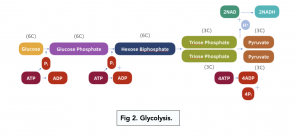The Stages and Products of Glycolysis (A-level Biology)
The Stages and Products of Glycolysis
Glycolysis
Steps of Glycolysis
Step 1: Phosphorylation of Glucose
1. Glucose enters the cytoplasm. Glucose (6C) is transported into the cytoplasm of cells through the GLUT transport protein.
2. Glucose is phosphorylated to hexose-1,6-biphosphate. The enzyme hexokinase phosphorylates the glucose to produce the molecule hexose-1,6-biphosphate. This requires the hydrolysis of 2 ATP molecules to form 2 ADP and two phosphate group (Pi). The two Pi groups are attached to glucose (making it a biphosphate).
Step 2: Splitting of Hexose-1,6-biphosphate
3. Hexose-1,6-biphosphate is split into two triose phosphates (TP). Hexose biphosphate (6C) is broken down and split to make 2 molecules of triose phosphate (3C). Hexose biphosphate had 6 carbons and 2 phosphate groups, so each triose phosphate (TP) has 3 carbons and 1 phosphate.
Step 3: Oxidation of Triose Phosphate
1. Triose phosphate is oxidised. Each TP molecule loses two hydrogen atoms (oxidation). Dehydrogenase enzymes catalyse this, but they need coenzyme NAD to help out. NAD combines with the released hydrogens, making reduced NAD. 2 ATP molecules are made due to phosphorylation of 2 ADP.
Step 4: Triose Phosphate → Pyruvate
2. Triose phosphate is converted to pyruvate. Each TP molecule (3C) is converted to a pyruvate molecule (3C). This conversion produces another 2 ATP molecules due to phosphorylation of 2 ADP.

Products of Glycolysis
For every molecule of glucose, glycolysis produces:
- 2 ATP – 2 ATP were used in step 1, and 4 ATP were made over steps 3 and 4. There is a net production of 2 ATP molecules.
- 2 reduced NAD – 2 molecules of reduced NAD were made in step 3. The reduced NAD will transport hydrogen atoms to the mitochondrial cristae, where they will be used in oxidative phosphorylation.
- 2 pyruvate – 2 molecules of pyruvate are made in step 4.
Destinations of Pyruvate
If respiration is only anaerobic, pyruvate can be converted to ethanol or lactate using reduced NAD. The oxidised NAD produced in this way can be used in further glycolysis.
If respiration is aerobic, pyruvate from glycolysis enters the mitochondrial matrix by active transport, and is used in the link reaction.
We will learn more about anaerobic respiration later. Now we will continue on to the next stage of aerobic respiration – the link reaction.
Glycolysis is the process by which glucose, a simple sugar, is broken down into two molecules of pyruvate. This process releases energy in the form of ATP, which cells can use to power their activities. Glycolysis is the first step in cellular respiration, which is the process by which cells produce energy from glucose and other fuels.
Glycolysis consists of 10 stages, each of which involves a different chemical reaction. The stages of glycolysis include:
Phosphorylation of glucose
Isomerization of glucose-6-phosphate
Phosphorylation of fructose-6-phosphate
Cleavage of fructose-1,6-bisphosphate
Formation of glyceraldehyde-3-phosphate
Conversion of glyceraldehyde-3-phosphate to 1,3-bisphosphoglycerate
Phosphorylation of 1,3-bisphosphoglycerate
Formation of 3-phosphoglycerate
Formation of 2-phosphoglycerate
Formation of pyruvate
The products of glycolysis include two molecules of pyruvate, two molecules of ATP, and two molecules of NADH. Pyruvate can be further metabolized in cellular respiration to produce more ATP, while NADH can be used to produce ATP through oxidative phosphorylation.
ATP is an important product of glycolysis and is used to provide energy for the cell. The process of glycolysis generates two molecules of ATP for each molecule of glucose that is metabolized. This ATP can be used to power a variety of cellular processes, including the transport of ions across the cell membrane and the synthesis of proteins and lipids.
NADH is another important product of glycolysis and is used to produce ATP through oxidative phosphorylation. NADH is generated in the later stages of glycolysis and serves as an electron carrier, transporting electrons from the glycolytic pathway to the electron transport chain. This allows cells to produce ATP through the transfer of electrons to oxygen, which acts as the final electron acceptor in cellular respiration.
Glycolysis is the first step in cellular respiration and provides the cell with energy in the form of ATP and NADH. Pyruvate produced by glycolysis is further metabolized in the citric acid cycle and the electron transport chain, which allow the cell to produce even more ATP through oxidative phosphorylation. Together, glycolysis, the citric acid cycle, and oxidative phosphorylation form the cellular respiration process, which provides cells with the energy they need to power their activities.






Still got a question? Leave a comment
Leave a comment